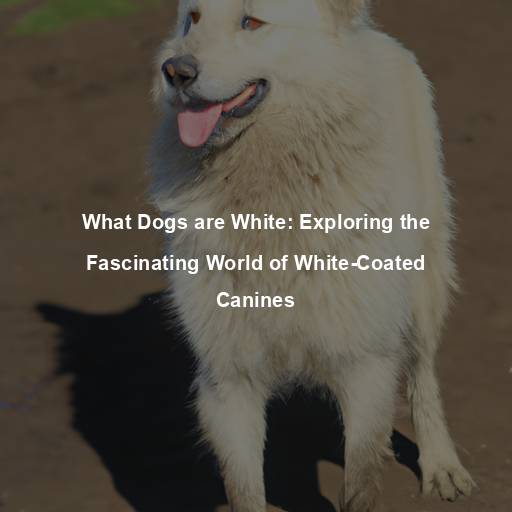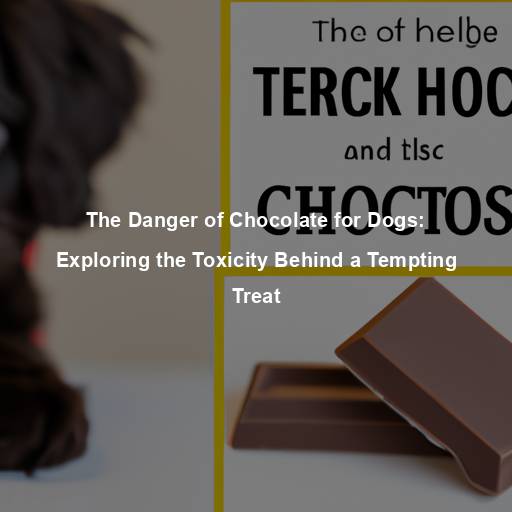What Dogs are White: Exploring the Fascinating World of White-Coated Canines
Last Updated on November 9, 2023 by Evan
Contents
- 1 The Allure of White-Coated Dogs
- 1.1 The Diverse World of White-Coated Breeds
- 1.2 The Genetic Basis of Coat Color
- 1.3 Historical Significance of White-Coated Breeds
- 1.4 The Appeal of White-Coated Dogs
- 1.5 Caring for White-Coated Canines
- 1.6 Embracing the Joy of White-Coated Companionship
- 1.7 The Role of Genetic Mutations
- 1.8 Coat Color Inheritance
- 1.9 Recognized White-Coated Breeds
- 1.10 Challenges of White-Coated Dogs
- 2 FAQs – What Dogs Are White
- 2.1 What dog breeds are commonly white?
- 2.2 Are all white dogs completely without any other color?
- 2.3 Are there health issues specific to white dogs?
- 2.4 Do white dogs require special grooming?
- 2.5 Are white dogs more prone to allergies or sensitive skin?
- 2.6 Can white dogs have a higher risk of deafness?
The Allure of White-Coated Dogs
Prepare to be bewitched by the enchanting allure of these ethereal creatures who don a coat as pure as freshly fallen snow. Mesmerizing in their elegance, these white-coated canines possess a captivating charm that leaves admirers in a state of blissful infatuation. Immerse yourself in the splendid tapestry of dog breeds that proudly boast a resplendent white coat as we navigate the labyrinth of their individual traits, rich histories, and the sheer delight they bring into our lives. Join us on this whimsical expedition as we unravel the enigmatic allure of these mesmerizing companions who have mastered the art of stealing hearts effortlessly.
The Diverse World of White-Coated Breeds
White-coated dogs come in an array of shapes, sizes, and temperaments. From small and fluffy to large and majestic, there is a white-coated breed to suit every individual’s preferences and lifestyle. Let’s explore some of the most beloved and distinctive white-coated breeds:
The Samoyed, with its ethereal white fur cascading like freshly fallen snow, holds a mystical allure. An embodiment of joy, these four-legged marvels have become known as the “smiling dogs,” their expressions radiating perpetual warmth and mirth. Hailing from the wilds of Siberia, they once adorned the lives of the Samoyede people, deftly herding reindeer and gracefully pulling sleds. Today, these gentle giants bestow their playful nature and unwavering devotion on lucky families, transforming them into havens of companionship and love.
Step into the world of pure sophistication with the captivating Bichon Frise. This elegant breed, boasting a coat of luscious white curls, has a beguiling charm that is hard to resist. Rewind to ancient times, when these furry companions graced the courts of French nobility, serving as loyal confidants. Fast forward to the present day, where their joyful nature and non-shedding coats continue to enrapture both the young and the young at heart.
- West Highland White Terrier: Commonly referred to as the “Westie,” this spirited and tenacious breed hails from Scotland. With their iconic white coats and perky ears, Westies are brimming with personality. Originally bred for hunting small game, they possess a strong prey drive and a curious nature.
The Genetic Basis of Coat Color
When it comes to our furry friends, the puzzle of a white coat goes beyond simply being cute and cuddly. It’s a whole genetic enigma! From breed to breed, this fascinating phenomenon unravels into a complex tapestry of genes and heredity. Some lucky breeds effortlessly flaunt their snowy coats, thanks to their genetic blueprint, while other adorably surprise us with their color-challenging genes.
Melanin and Coat Color
Coat color in dogs is determined by the distribution and concentration of melanin, the pigment responsible for the coloration of skin, hair, and eyes. Melanin production is regulated by genes, and variations in these genes can lead to different coat colors. In the case of white-coated dogs, there are two main genetic factors at play:
- Eumelanin: This type of melanin produces black or brown pigmentation in the coat. Dogs with a white coat lack eumelanin due to genetic mutations that prevent its production. As a result, the absence of eumelanin causes the coat to appear white.
Did you know that the red or yellow hues in a dog’s coat are caused by a pigment called phaeomelanin? Interestingly, in dogs with white coats, the genes that control phaeomelanin are often unaffected, leading to the manifestation of this vibrant pigment. However, the dilution effect caused by the absence of another pigment called eumelanin creates a perplexing twist, giving these dogs a cream or pale yellow color instead of the expected pure white coat.
Historical Significance of White-Coated Breeds
White-coated dogs have played significant roles throughout history, serving various purposes and often symbolizing certain cultural values. Let’s explore some intriguing historical connections of white-coated breeds:
Guardians of Royalty
In many cultures, white-coated dogs were highly prized and revered as symbols of royalty and prestige. For instance, the white Pomeranian, favored by Queen Victoria of England, became synonymous with elegance and regality. Similarly, the Japanese Akita, often depicted in white, was considered a symbol of good fortune and loyalty.
Working Companions
Throughout the annals of time, a multitude of magnificent breeds, adorned in their dazzling white coats, have fearlessly roamed the realms of duty and responsibility. Among these stalwart guardians, the Great Pyrenees reigns supreme, its regal presence and snowy fur perfectly attuned to the treacherous landscapes of the Pyrenees Mountains. From the depths of Hungary emerges the valiant Kuvasz, a steadfast and loyal protector of both livestock and land. In the enigmatic tapestry of history, these white-coated warriors stand as testament to the indomitable spirit and unwavering commitment of our canine companions.
Religious and Mythological Significance
Throughout different mythologies and diverse religious traditions, there exists an enchanting tapestry of beliefs surrounding white-coated canines. These ethereal beings, adorned in their pristine fur, have woven themselves into the sacred narratives of ancient civilizations. For instance, in the rich tapestry of Norse mythology, the ethereal Icelandic Sheepdog, donning its resplendent white coat, was revered as a luminous guide, beckoning souls to the mystic realms beyond. Equally revered in ancient Egyptian culture, the majestic Saluki, gliding gracefully in its divine white attire, was held as a sacred emissary, bestowing blessings upon those fortunate enough to call it companion.
The Appeal of White-Coated Dogs
There’s an undeniable enchantment surrounding white-coated dogs that goes well beyond their superficial charm. These mesmerizing companions possess an array of unique qualities and characteristics that have ignited a global fascination. Let’s dive into the captivating world of white-coated dogs and unravel the enigmatic reasons they’ve become adored by dog lovers around the globe.
When it comes to aesthetics, there is something truly enchanting about the allure of a white coat. The sheer beauty of a perfectly groomed dog with its pristine white fur is simply mesmerizing, emanating an air of elegance and sophistication that is undeniable. It’s hard not to be captivated by the crisp and immaculate appearance of a well-maintained white-coated canine, leaving us in awe and wonder.
When it comes to cleanliness and shedding, it’s no secret that some dogs have a leg up. While it’s important to note that no dog is completely hypoallergenic or shed-free, those with white coats seem to have a hidden advantage. Their lighter fur has a knack for seamlessly blending into the background, making it less of an eyesore on your furniture and clothing. So if you’re looking for a furry friend with a touch of elegance and less visible shedding, consider embracing the burst of brightness that white-coated dogs offer.
- Personality: White-coated dogs come in a wide range of breeds, each with its own distinct personality traits. From the playful and sociable Bichon Frise to the regal and independent West Highland White Terrier, there is a white-coated breed to suit every individual’s preferences and lifestyle.
One of the most captivating aspects of white-coated breeds is their remarkable versatility, effortlessly excelling in a multitude of roles. From being gentle therapy dogs, to captivating the audience at dog shows, and being the epitome of loyalty as family pets, these breeds truly embody adaptability at its finest. With their innate trainability, they effortlessly transition between different activities and environments, leaving everyone in awe of their remarkable abilities.
Caring for White-Coated Canines
When it comes to embracing the elegance of a white-coated canine companion, one must navigate the intricate path of maintenance and care. The ethereal beauty that their pristine coats exude demands ongoing dedication. To ensure your snowy companion shines effortlessly, we present essential tips tailored to bestow a perpetual state of flawlessness upon them.
Regular Grooming
When it comes to keeping your four-legged friend looking fabulous, regular grooming is an absolute must. A diligent brushing routine not only untangles and prevents matting, but it also removes all those pesky loose hairs and unwanted debris. And for that extra gleam, a luxurious bath using a top-notch whitening shampoo will work wonders in maintaining that pristine white hue. Trust us, these simple yet effective steps will leave your pooch bursting with beauty and perplexing onlookers with their impeccable coat.
Sun Protection
Did you know that white-coated dogs are particularly prone to sunburn and skin damage? It’s all because of the lack of pigmentation in their beautiful coats. To shield their sensitive skin, it’s important to reduce their time in the sun, especially during the brightest hours. And here’s a brilliant tip: you can apply specially formulated sunscreen to their exposed areas, like their nose and ears, for some added protection.
Avoiding Stains
Keeping our furry friends looking their best can sometimes be a challenging task, especially for those with a beautifully white coat. One common issue that white-coated dogs face is staining, particularly in those delicate areas around their face and paws. But worry not, as there are simple solutions to keep those unsightly marks at bay. By incorporating a regular cleaning routine using a gentle and pet-safe cleanser, you can effectively prevent discoloration and keep your pup looking pristine.
Embracing the Joy of White-Coated Companionship
Adding a frosty touch to your family, the presence of a snow-colored canine promises boundless delight and camaraderie. With their eye-catching exteriors and idiosyncratic characters, these four-legged companions guarantee an unforgettable journey. Be it a Samoyed, Bichon Frise, West Highland White Terrier, or any other ethereal breed, there’s no doubt that the affection and devotion they bestow upon you are beyond measure.
Unlocking the enigmatic realm of white coats is a perplexing odyssey into the intricate world of genetics. Delving deep into the complexities of hereditary traits, the mysterious allure of these pristine garments captivates our curiosity. With each thread of information, we unravel the burst of secrets concealed within the DNA blueprint, shedding light on the enigmatic origins of this sartorial phenomenon. Prepare to embark on a journey that fuses science and style, as we decode the genetic makeup of the elusive white coats.
The Role of Genetic Mutations
White coats in dogs are often the result of genetic mutations that affect the production of pigmentation in the hair follicles. These mutations can either prevent the production of melanin altogether or dilute its color, resulting in a white appearance. It’s important to note that not all white-coated dogs are the same genetically. Different breeds may have specific genetic variations that contribute to their white coat coloration.
Coat Color Inheritance
The enigmatic world of dog coat color inheritance proves to be a kaleidoscope of complexity, where a symphony of multiple genes dance delicately to determine the hues and shades that cloak our beloved canines. Each breed boasts a unique genetic puzzle, where inheritance patterns become an enigmatic web of whispers. In the realm of white-coated dogs, the fickle presence or absence of specific genes emerges as the ultimate arbiter of their beguiling canvas. As generations intertwine, these mysterious genes surreptitiously thread through the lineage, weaving their spell to create a steadfast tapestry of snowy elegance in select breeds.
Recognized White-Coated Breeds
Throughout history, dog enthusiasts have marveled at the enchanting allure of certain breeds adorned with exquisite white coats. The intricate process of selective breeding has played a pivotal role in preserving the pristine brilliance of these distinctive breeds for countless generations. Among the ranks of these illustrious canines, a few remarkable white-coated breeds have emerged to captivate our collective imagination and leave us pondering the mysteries of their ethereal beauty.
-
Maltese: The Maltese is a small toy breed known for its long, silky white coat. Originating from the Mediterranean, this breed has been a beloved companion for centuries. Their white coat requires regular grooming to keep it looking its best.
-
American Eskimo Dog: With its fluffy white coat and intelligent expression, the American Eskimo Dog is an eye-catching breed. Despite its name, this breed actually originated in Germany. American Eskimo Dogs are known for their agility and trainability.
The West Highland White Terrier, affectionately known as the Westie, has captured the hearts of many with its unique snowy white fur. With a rich history rooted in its origins as a hunting companion for small prey, these terriers have developed a reputation for their spirited and self-reliant nature. It is no wonder that they continue to be a favorite among dog enthusiasts worldwide.
When it comes to the Siberian Husky, prepare to be mesmerized by their enchanting blue eyes and captivated by their stunning white coats. But their beauty is just the beginning, as these four-legged wonders are bursting with energy and a penchant for outdoor adventures. Whether it’s a thrilling run through the snow or an exhilarating hike in the mountains, the Siberian Husky is sure to keep you perplexed and entertained with their endurance and friendly nature.
Challenges of White-Coated Dogs
Owning a beautiful white-coated canine companion can bring immense joy to anyone’s life. However, it is important to recognize the distinctive hurdles that come with these delightful furry friends. From their susceptibility to stains and dirt to the continuous upkeep required to maintain their pristine appearance, these challenges demand our attention and understanding as responsible pet owners. Nevertheless, with careful consideration and dedication, navigating these complexities can ultimately enhance the bond between pet and owner, resulting in a truly rewarding partnership.
Stain Visibility
Keeping your furry companions spotlessly clean is no small feat, especially if they happen to be blessed with a magnificent, snow-white coat. The immaculate allure of white fur, while undeniably stunning, comes with its fair share of challenges. They say that beauty comes at a price, and for owners of white-coated dogs, that price is eternal vigilance against the forces of dirt, food mishaps, and all sorts of perplexing substances that seem to have an uncanny knack for targeting spotless surfaces. But fear not, dear owners, for with a diligent approach to cleanliness, along with a steady supply of clean water and pristine sustenance, your beloved pets’ dazzling white coats can continue to shine with breathtaking luminosity.
Sun Sensitivity
The lack of pigmentation in white coats makes these dogs more vulnerable to sunburn and skin damage. It is important to protect white-coated dogs from prolonged sun exposure by providing shade, using pet-safe sunscreen, and minimizing outdoor activities during peak sunlight hours.
Grooming Needs
Keeping white coats pristine is a demanding task that involves a meticulous grooming routine. Regular brushing is key in preventing unsightly tangles and matting, while therapeutic baths with specialized whitening shampoos work wonders in preserving their dazzling brightness. Despite these efforts, one must not overlook the pesky tear stains that often plague our beloved white-coated canines, requiring targeted cleaning solutions to restore their flawless appearance.
Maintenance of Coat Color
As the caretakers of these lovely creatures, let’s delve into the mysteries of maintaining their brilliant snow-white coats. A word of caution – tread carefully when it comes to the products we choose, for they can hold the power to dull their radiance. Avoid any brushes with grass, mud, or any dyes that may leave behind unwelcome marks. And in the realm of food and water, let’s embrace the wonders of stainless steel bowls, shielding our beloved pets from the perils of staining caused by unsightly plastic remnants.
FAQs – What Dogs Are White
What dog breeds are commonly white?
When it comes to canine companions, there is a captivating array of breeds that effortlessly sport a pristine, snow-like coat. Within this fascinating group, we encounter the elegant Bichon Frise, the charming Maltese, the majestic Samoyed, the spirited West Highland White Terrier, the iconic Dalmatian, the regal Great Pyrenees, the playful American Eskimo Dog, the enchanting Japanese Spitz, and last but not least, the delightful White Pomeranian. Each of these breeds possesses a unique blend of snowy shades and mesmerizing patterns, embarking on their glorious quest of captivating hearts with their unmistakable snowy allure.
Are all white dogs completely without any other color?
Not all white dogs are completely without any other color. Some white dog breeds can have patches or markings of different colors on their fur, while others may have pigmented skin that is visible in certain areas. It is important to note that the extent and distribution of these colors or markings can vary among individuals within the same breed.
Are there health issues specific to white dogs?
In some cases, white dogs are more prone to certain health issues compared to dogs of other colors. For instance, white dog breeds with pink skin are more susceptible to developing sunburns, which can lead to skin damage and even skin cancer. Additionally, some white dogs may be more prone to certain hereditary conditions that can affect their vision or hearing. However, it is crucial to remember that not all white dogs will experience these health issues, and proper care and precautions can help minimize any potential risks.
Do white dogs require special grooming?
Caring for majestic white canines, especially those blessed with luscious locks, demands an extra touch of finesse to ensure their coat gleams with unparalleled radiance. Embracing a routine of diligent brushing not only thwarts the clutches of tangling but also purges their precious fur of any soil or impurities that dare to besmirch its pristine beauty. On occasion, certain pedigrees might necessitate the expertise of grooming maestros to safeguard the luminosity of their snowy cover, as the passage of time might introduce untoward staining and discoloration. Furthermore, tenderly tending to a white hound’s visage and keeping it perpetually dry assumes vital importance in averting the bane of tear stains, especially for breeds that flaunt captivating, gaze-capturing ocular orbs.
Are white dogs more prone to allergies or sensitive skin?
Having a white dog doesn’t automatically mean they’ll have allergies or sensitive skin, but it’s not completely out of the realm of possibilities. Just like humans, dogs of any color or breed can experience allergic reactions or skin irritations. If you notice your furry friend displaying symptoms of allergies or skin irritations, it’s best to seek guidance from a knowledgeable veterinarian. They will be able to pinpoint the issue and provide specialized treatment options based on your dog’s unique situation.
Can white dogs have a higher risk of deafness?
When it comes to our beloved furry friends, it’s important to be aware of the unique challenges certain dog breeds may face. Take, for instance, those adorable pups with a predominantly white coat – while not all of them are deaf, some may be at a higher risk due to genetic factors. This susceptibility is often more prevalent in breeds with eye-catching patterns like piebald or merle. So, if you’re thinking of welcoming a white canine companion known for potential deafness, it’s crucial to educate yourself about their breed-specific health risks and conduct thorough health testing, ensuring their overall well-being.







